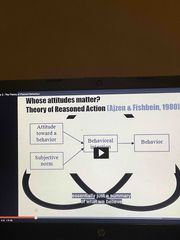![]()
![]()
![]()
Use LEFT and RIGHT arrow keys to navigate between flashcards;
Use UP and DOWN arrow keys to flip the card;
H to show hint;
A reads text to speech;
14 Cards in this Set
- Front
- Back
|
what is the learning outcome? |
3.2 describe and apply to real world settings, the theory of planned behaviour and its core components 3.3 describe previous emotional applications of the theory of planned behaviour |
|
|
what isn’t consider when we think of attitudes as a cause of behaviour? |
other people attitudes, peer pressure. |
|
|
what role does social pressure take |
it trumps our negative attitudes and leads to contradictory behaviour |
|
|
why is it important to study attitudes? |
can be key for social change ie mask implementation or anti social behaviours. |
|
|
what is ajzen and fishbeins theory of reasoned action? and provide the year of the theory. |

Back (Definition) |
|
|
what is a subjective norm? |
also called an injunctive norm, this is the perceived approval or disapproval for behaviour from the attitudes of those significant focus |
|
|
what did mcmillan and Conner do and when? |
a study to predict drug use intentions in 2003. measures of personal attitudes and subjective norms gathered as well as intentions to take drugs over the next six months. |
|
|
what did mcmillan and Conner find |
for lsd, attitude was important and has a strong predictive effect on intention (.476) but was so injunctive norms, just lesser so (.133). similar for amphetamine, (less strong effect), cannabis and ecstasy |
|
|
so why do we act against our own attitudes ? |
the subjective norm matters more to us, or favours us doing something, more so than our own attitude. the theory of reasoned action explains that if we are more motivated to comply to an injunctive norm, we will dismiss our personal attitudes |
|
|
what is the theory of planned behaviour |
an amendment to the theory of reasoned action from 1985/1991 that makes way for the fact that our inability to do something is another factor in whether or not our behaviours align to our attitudes |
|
|
what is perceived behavioural control |
in the theory of planned behaviour, it is the factor that prevents us from forming an intention to carry out a behaviour. it competes with attitude to influence our behaviour, and so does injunctive norms. |
|
|
outline theory of planned behaviour in relation to dental flossing and how each element was measured |
Lavin and Groarke 2002 used the TPB in a study to try and predict variation in students flossing behaviour. attitude measure: using dental floss over the next 3 weeks would be (good…..bad)
subjective norm measure: most people who are important to me think i should floss my teeth everyday for the next 3 weeks (agree/disagree) perceived behavioural control measure: for me, using dental floss everyday for the next 3 weeks would be (easy….difficult) intention measure: i intend to floss my teeth everyday for the next 3 weeks (agree/disagree) behaviour: 3 weeks later, self report |
|
|
what are regression models |
they tell us how much of the dependent variable the predictors explain, and which ones have the most unique impact. |
|
|
what was found in dental flossing student |
attitude:.28 - high impact subjective norm: .09- no impact pbc: .48- strong impact intention and pbc explained 31% variance in behaviour. |

